News
Attend the Tale: The Lurid Literary History of Sweeney Todd

Mention the name Sweeney Todd today and most modern horror fans’ minds will turn to Stephen Sondheim’s sensational stage–and later screen–musical Sweeney Todd: The Demon Barber of Fleet Street.
It’s not difficult to understand why. Sondheim’s version of the story may be the most famous of the last 175 years, and has been performed by some of the most talented theater companies around the world long before it ever came to life on the big screen under the direction of Tim Burton and starring Johnny Depp and Helena Bonham-Carter.
Mr. Todd’s history goes back much farther than the 1979 Broadway premiere of Sondheim’s musical, however. In fact, it began in literary form in 1846 in a penny dreadful serial titled “The String of Pearls: A Domestic Romance.”
“The String of Pearls” Synopsis
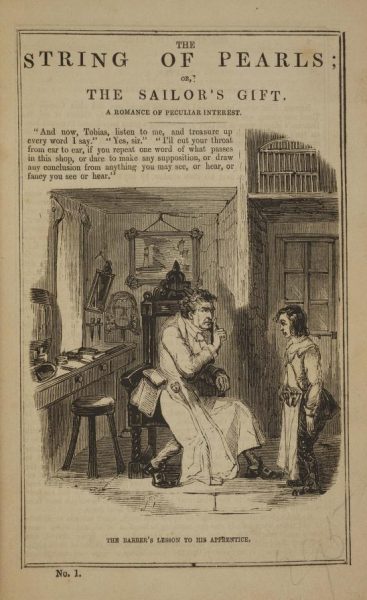
That original story painted Sweeney Todd as an unmitigated villain who killed his victims by pulling a lever on his barber chair that sent them crashing down a chute into the basement where, hopefully, their necks would break. When he wasn’t so lucky, he would descend the stairs and slit their throats with his razor.
Once dispatched, he would cart the bodies by way of an underground tunnel to Mrs. Lovett’s Meat Pie shop where she’d bake them up to sell to the public.
Things go awry for Mr. Todd after a sailor named Thornhill, last seen entering the shop, goes missing. Thornhill had been meant to deliver a string of pearls to a woman named Johanna. It was a gift from, Mark, a man she loved who was presumed lost at sea.
Suspicious of Todd’s involvement in Thornhill’s disappearance, Johanna dresses up like a boy and goes to work for his shop after his former assistant Tobias Ragg is locked away in an asylum upon accusing the barber of being a murderer.
Eventually, Todd is exposed as the villain he is when massive piles of body parts are discovered under the nearby church that is also connected to the barber’s shop by underground tunnels. Furthermore, it is discovered that Johanna’s long lost Mark has been imprisoned for ages by Mr. Todd and forced to cook the meat pies for Mrs. Lovett’s shop.
Mark manages to escape and enters the pie shop, announcing to the customers that they are actually eating people. I’ve often wondered if Soylent Green doesn’t owe just a little bit of it’s success to old Sweeney.
In the fallout that comes after his exposure, Todd poisons Mrs. Lovett and is eventually captured and hanged for his crimes.
Adaptations
Nope, we’re not even close to Mr. Sondheim yet!
The tale of Sweeney Todd and “The String of Pearls” was so popular that it was adapted for the stage before the original story’s ending was even revealed in serial form, and soon everyone was doing their own version of the tale from the grand guignol theaters of Europe to America and back to London for newer versions making Sweeney Todd a household name in Victorian England.
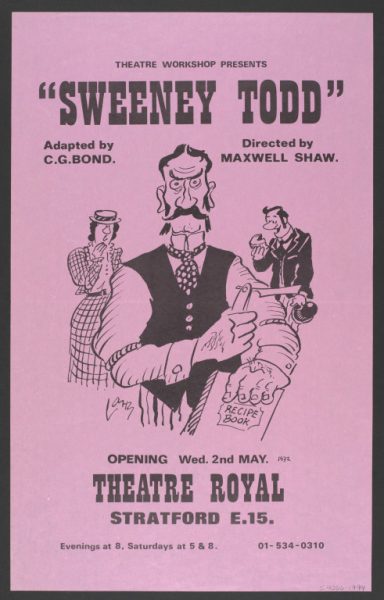
And then, in 1970, playwright Christopher Bond took the tale and gave it his own spin.
In Bond’s version of the tale, Sweeney Todd became a slightly more sympathetic character. He wasn’t a killer from the start. Instead, he was a barber whose beautiful wife became the object of obsession for an evil judge who raped the woman and then had Todd transported to Australia on trumped up charges.
Upon his return to London, he begins his bid for revenge, falling in with Mrs. Lovett and hatching a plot to boost her pie sales while seeking an end to the evil judge’s life.
It was in 1973 that Stephen Sondheim saw a production of Bond’s play. It planted the seeds for his own adaptation which has become, by far, the most well-known version of the tale in the last four decades.
Singing Sweeney Todd
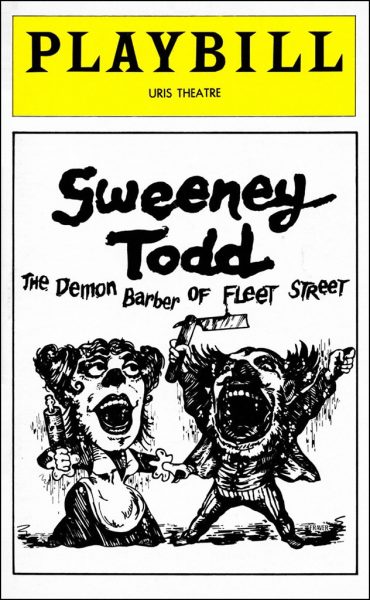
Sondheim took the material to his long-time collaborator Harold Prince and though the director was reticent at first, he was soon won over by Sondheim’s scoring ideas merged with his own ideas of making a statement about life in the Industrial Revolution–Prince’s sets would eventually come to look and feel like an old iron foundry with movable set pieces that actors could turn throughout to set different scenes.
Though it took a bit of convincing on his part, Sondheim found his leading lady for the comically villainous Mrs. Lovett in Angela Lansbury and for the titular role, he brought in actor Len Cariou.
Further, Sondheim turned the smaller roles and extras in the chorus into an actual Greek Chorus who would come onto the stage en masse to narrate certain passages through song, lending an almost operatic feel to the show.
On opening night, audiences were in shock at the tale of bloodshed, cannibalism, and revenge, and though reception by critics was somewhat lukewarm, it would go on to run for 557 performances on Broadway before it set out on tour with Lansbury still attached to the role of Lovett.
Cariou was replaced by George Hearn for the tour, and in the final leg of Sweeney Todd on the road, the production was filmed for broadcast on television. You can still purchase that production on DVD, and I cannot tell you how much I recommend it.
Since its initial run at the Uris Theater in New York, Sweeney Todd: The Demon Barber of Fleet Street has been performed all over the world and has seen numerous revivals on Broadway and in London’s West End.
In my opinion, Sweeney Todd contains some of the composer and lyricist’s best work. The darkly hilarious “A Little Priest” and “By the Sea” perfectly offset soaring ballads and more serious pieces like “Johanna” and “Epiphany.”
Sweeney on Screen
Of course, eventually Hollywood came to call upon Sondheim, and in 2007 Tim Burton’s gritty adaptation of the show hit the silver screen.
Now don’t come after me, but of all the version of this show that I’ve seen, Burton’s is by far the weakest. They simply had to cut too many things in the adaptation and they went with “name” talent over real singing actors. While I appreciate much of what they did in the film version of the story, you’ve not really seen this show until you’ve seen it in its entirety and by actors who are more accomplished vocalists than Depp and Bonham-Carter.
The film version of the musical was hardly the first screen adaptation of the story of Sweeney Todd, however. For that, you have to go all the way back to 1926. Unfortunately the film, which was directed by George Dewhurst and starred G.A. Baughan in the title role, has been lost.
The story was adapted for the screen again in 1928 and again in 1936, this time with George King directing. King’s version was actually chosen as one of the first 200 films to be broadcast on television and was first seen on WNBT Channel 1 out of New York City.
It has since been adapted by the BBC more than once, and has captured audiences each and every time.
But why Sweeney?
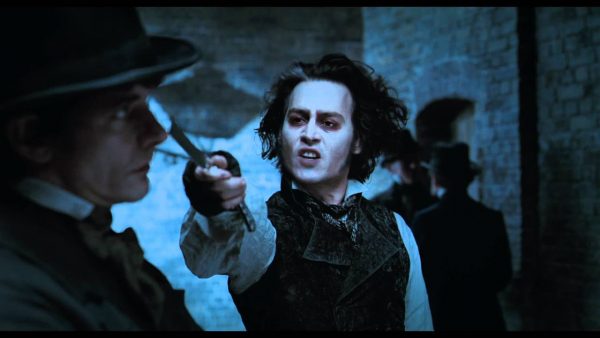
So why is it that this story has so captured the imagination of authors, playwrights, and filmmakers? What is it in the tale of Sweeney Todd that draws audiences to it again and again?
Of course, there is the lurid nature of the tale. Murder most foul and the unexpected twist of feeding human flesh to unexpected shop patrons is a sensational idea!
But is that all? It’s certainly part of the reason why I love it, and I’ve often wondered what I would do if I found out that I’d unintentionally taken part in cannibalism. Of course, I’m a bit weird so maybe only I have those thoughts.
While I’m sure academics could and would give you a host of reasons, I think it comes down to basic human nature.
Sweeney Todd could be anybody. He could be your neighborhood barber or even worse your neighbor.
There is both a repulsion and a slight thrill innate in human beings when they find them connected to such circumstances. One only has to read or watch the news after a heinous murderer or serial killer is captured to see it. Friends, neighbors, and acquaintances line up for interviews to talk about how they never would have suspected the killer of doing such terrible things.
Whatever the part of our brain is that drives human to relish that contact with such horrifying circumstances, I would lay money on it being the same part that has kept the story of Sweeney Todd alive.
Listen to the 'Eye On Horror Podcast'

News
Brad Dourif Says He’s Retiring Except For One Important Role
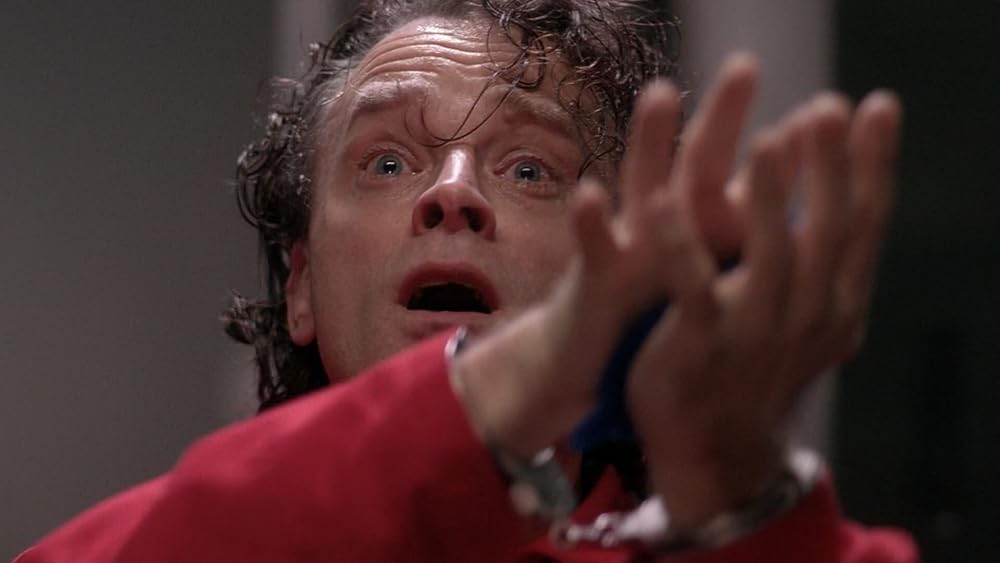
Brad Dourif has been doing movies for nearly 50 years. Now it seems he is walking away from the industry at 74 to enjoy his golden years. Except, there is a caveat.
Recently, digital entertainment publication JoBlo’s Tyler Nichols talked to some of the Chucky television series cast members. During the interview, Dourif made an announcement.
“Dourif said that he’s retired from acting,” says Nichols. “The only reason he came back for the show was because of his daughter Fiona and he considers Chucky creator Don Mancini to be family. But for non-Chucky stuff, he considers himself retired.”
Dourif has voiced the possessed doll since 1988 (minus the 2019 reboot). The original movie “Child’s Play” has become such a cult classic it’s at the top of some people’s best chillers of all time. Chucky himself is ingrained in pop culture history much like Frankenstein or Jason Voorhees.
While Dourif may be known for his famous voiceover, he is also an Oscar-nominated actor for his part in One Flew Over the Cuckoo’s Nest. Another famous horror role is The Gemini Killer in William Peter Blatty’s Exorcist III. And who can forget Betazoid Lon Suder in Star Trek: Voyager?
The good news is that Don Mancini is already pitching a concept for season four of Chucky which might also include a feature-length movie with a series tie-in. So, Although Dourif says he is retiring from the industry, ironically he is Chucky’s friend till the end.
Listen to the 'Eye On Horror Podcast'
Editorial
7 Great ‘Scream’ Fan Films & Shorts Worth a Watch
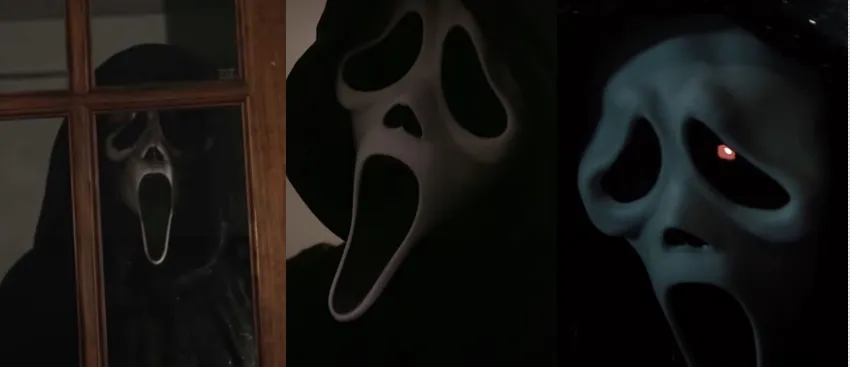
The Scream franchise is such an iconic series, that many budding filmmakers take inspiration from it and make their own sequels or, at least, build upon the original universe created by screenwriter Kevin Williamson. YouTube is the perfect medium to showcase these talents (and budgets) with fan-made homages with their own personal twists.
The great thing about Ghostface is that he can appear anywhere, in any town, he just needs the signature mask, knife, and unhinged motive. Thanks to Fair Use laws it’s possible to expand upon Wes Craven’s creation by simply getting a group of young adults together and killing them off one by one. Oh, and don’t forget the twist. You’ll notice that Roger Jackson’s famous Ghostface voice is uncanny valley, but you get the gist.
We have gathered five fan films/shorts related to Scream that we thought were pretty good. Although they can’t possibly match the beats of a $33 million blockbuster, they get by on what they have. But who needs money? If you’re talented and motivated anything is possible as proven by these filmmakers who are well on their way to the big leagues.
Take a look at the below films and let us know what you think. And while you’re at it, leave these young filmmakers a thumbs up, or leave them a comment to encourage them to create more films. Besides, where else are you going to see Ghostface vs. a Katana all set to a hip-hop soundtrack?
Scream Live (2023)
Ghostface (2021)
Ghost Face (2023)
Don’t Scream (2022)
Scream: A Fan Film (2023)
The Scream (2023)
A Scream Fan Film (2023)
Listen to the 'Eye On Horror Podcast'
Movies
Another Creepy Spider Movie Hits Shudder This Month

Good spider films are a theme this year. First, we had Sting and then there was Infested. The former is still in theaters and the latter is coming to Shudder starting April 26.
Infested has been getting some good reviews. People are saying that it’s not only a great creature feature but also a social commentary on racism in France.
According to IMDb: Writer/director Sébastien Vanicek was looking for ideas around the discrimination faced by black and Arab-looking people in France, and that led him to spiders, which are rarely welcome in homes; whenever they’re spotted, they’re swatted. As everyone in the story (people and spiders) is treated like vermin by society, the title came to him naturally.
Shudder has become the gold standard for streaming horror content. Since 2016, the service has been offering fans an expansive library of genre movies. in 2017, they began to stream exclusive content.
Since then Shudder has become a powerhouse in the film festival circuit, buying distribution rights to movies, or just producing some of their own. Just like Netflix, they give a film a short theatrical run before adding it to their library exclusively for subscribers.
Late Night With the Devil is a great example. It was released theatrically on March 22 and will begin streaming on the platform starting April 19.
While not getting the same buzz as Late Night, Infested is a festival favorite and many have said if you suffer from arachnophobia, you might want to take heed before watching it.
According to the synopsis, our main character, Kalib is turning 30 and dealing with some family issues. “He’s fighting with his sister over an inheritance and has cut ties with his best friend. Fascinated by exotic animals, he finds a venomous spider in a shop and brings it back to his apartment. It only takes a moment for the spider to escape and reproduce, turning the whole building into a dreadful web trap. The only option for Kaleb and his friends is to find a way out and survive.”
The film will be available to watch on Shudder starting April 26.
Listen to the 'Eye On Horror Podcast'
-

 News4 days ago
News4 days agoThis Horror Film Just Derailed a Record Held by ‘Train to Busan’
-

 Movies4 days ago
Movies4 days agoWatch ‘Immaculate’ At Home Right Now
-

 News3 days ago
News3 days agoHome Depot’s 12-Foot Skeleton Returns with a New Friend, Plus New Life-Size Prop from Spirit Halloween
-

 News5 days ago
News5 days agoRead Reviews For ‘Abigail’ The Latest From Radio Silence
-

 News2 days ago
News2 days agoWoman Brings Corpse Into Bank To Sign Loan Papers
-

 News4 days ago
News4 days agoMelissa Barrera Says Her ‘Scream’ Contract Never Included a Third Movie
-

 Editorial5 days ago
Editorial5 days agoRob Zombie’s Directorial Debut Was Almost ‘The Crow 3’
-

 News4 days ago
News4 days agoA24 Joins Blockbuster Movie Club With Their Biggest Opening Ever




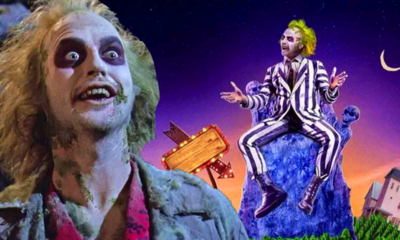























You must be logged in to post a comment Login